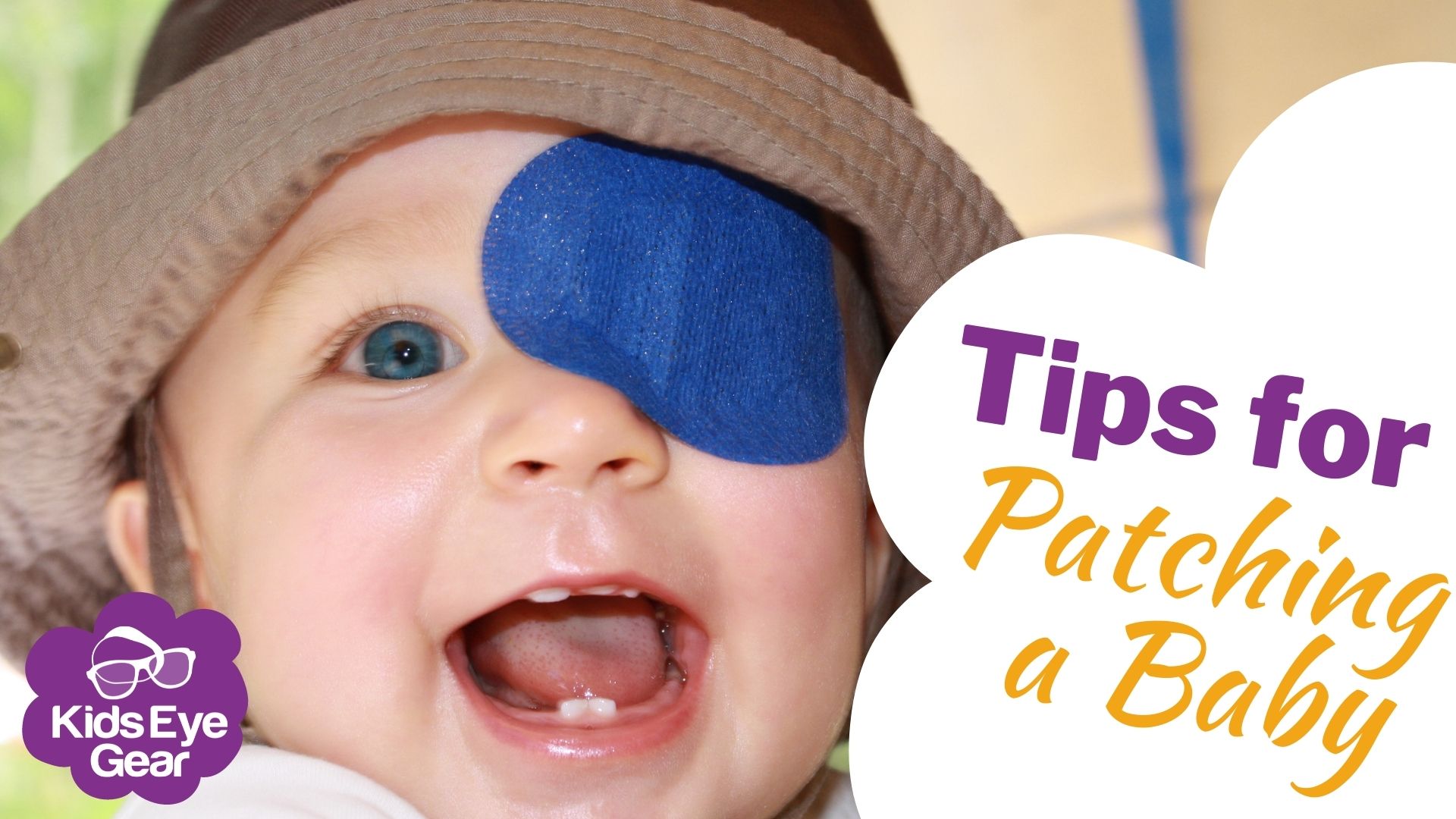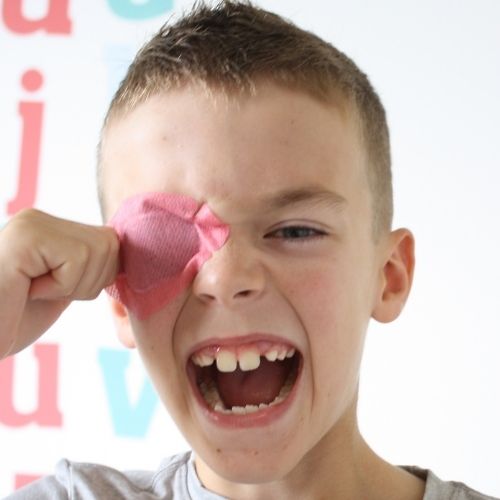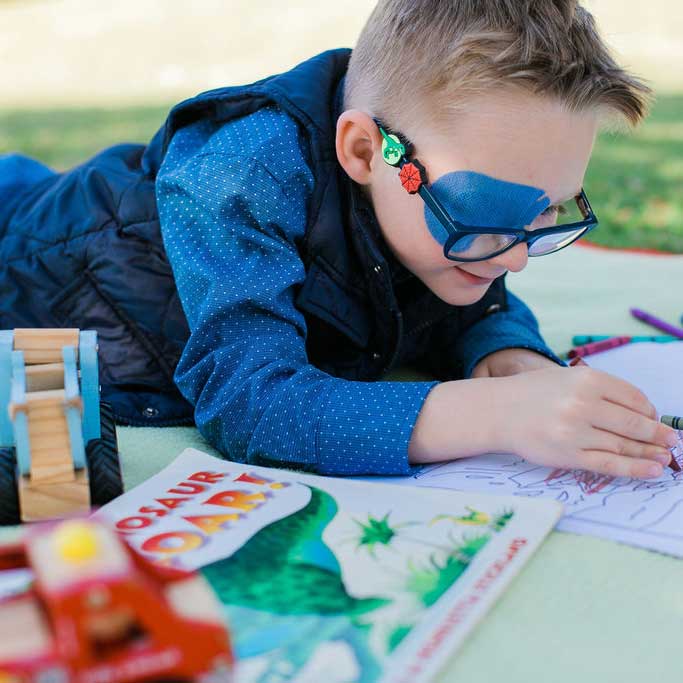Tips to get babies to patch
4th Nov 2021

“How can I get my baby to wear their eye patch?”
“Can anyone help me with tips for patching my baby?”
These are questions I see almost every day in various Facebook groups.
If you’re anything like us and had to start patching your child when they were a baby, it can come as a bit of a shock. After Dane’s diagnosis with a unilateral congenital cataract at 6 months of age, we were faced not only with surgery but with the likelihood of years of patching him as well. I’d worn an eye patch as a child for a brief amount of time but really didn’t know much about patching – or how on earth we would get our infant son to comply with almost full time patching!
After five years of patching, and eight years of helping customers with their own patching journeys, here are my top tips for patching a baby.
1. Find a patch that works for you
Fortunately for parents there are now quite a lot of options when it comes to patches, this certainly wasn’t the case when we started patching, which is why we started Kids Eye Gear! But we went through three brands before we found the perfect patch for our baby. Sometimes this can be a bit of trial and error because every child’s skin is different and will tolerate different patches.
When it comes to the type of patch, you basically have two options – adhesive or fabric. Adhesive patches stick like a Band-Aid to the skin, while fabric patches typically go onto glasses, although there are a few that operate like a ‘pirate patch’ on a band.
Since very few babies under 12 months of age wear glasses, adhesive patches are typically the go-to for this age group. Don’t be afraid to give a few brands a try to see what works for you – and if you can, ask the company if they will provide samples so you can try without investing a great deal of money.
2. Loosen the adhesive before applying
Babies’ skin can be super sensitive so it’s not unusual for adhesive patches to cause a bit of irritation in the beginning – or even ongoing – if you don’t find the right patch for you kid. An easy solution is to stick the patch to your skin or clothing before applying it to your child’s skin. This helps to break down the adhesive so it’s not as sticky.

3. Don’t just rip the patch off
Ripping an adhesive patch off can cause a great deal of irritation to sensitive skin. The best way to remove a patch is to rub either water, olive oil, coconut oil or adhesive removal wipes around the adhesive, allow to sit for a few minutes and then it should just slide right off.
4. Routine, routine, routine
Now that you’ve found a patch that works for you, it’s time to get down to business with getting your patching hours in. A great way to do this is to establish a routine. They might be babies but they will quickly work out what is happening if patching is done regularly and at the same time of the day each day. Many parents find that patching in the morning is the best way to keep the patch on, as the babies are more alert and generally happier. Avoid the ‘witching hour’ at all costs! It’s hard enough getting through that without having to deal with patching as well!

5. Distract, distract, distract
Once a baby knows they can pull the patch off, they’ll have a delightful time in doing so. It’s not uncommon for babies to pull upwards of 5 patches off in a day – our record was 11 in one day! So keeping them distracted and busy can really help. Some ideas include light up toys, musical toys, singing and dancing, taking them for a walk, going outside to play, taking them to nursery rhyme time at the library and even baby gymnastics classes can be great distractions. It might be quite time and energy intensive to keep them distracted while patching so if you need to, break it down into chunks of time.
6. Keep putting them on
When baby does work out they can pull their patch off (and they will), they’ll probably do it a lot! Being consistent and persistent in reapplying the patch is absolutely imperative here. It might break your heart that they cry or scream when the patch goes on but remember that you’re doing this for their future – so they can have the best vision possible. Just keep putting the patch on and be firm about it. This can be really tough but they won’t remember this time in their lives – all they’ll know is that they can (hopefully!) see.
7. Consider the environment they’re in while patching
Think about what your baby might be seeing when they’re patched. Depending on the level of vision they have in their eye that is being treated, they might see quite a lot, a little or almost nothing at all. This can be very distressing and upsetting for a little one. Try to keep them in a well lit place, as the brighter an environment, the easier it will be for them to see. If they are stressed, try to stay close so they can at least see your shape, and talk or sing so they know you’re there.
8. Share the load
It can be mentally, emotionally and physically exhausting to care for a baby – let alone a baby that needs to patch! If you have help around you, don’t be afraid to ask for it! Even if you have a grandparent, cousin, kid next door that you can ask to spend 30 minutes or an hour entertaining your baby patcher, this can give you a much-needed break and help to get your patching hours in.
9. Restraints might help
If you’re at your wits end, some parents suggest trying arm restraints – or floaties. Like the blow up floaties we had as kids, if you pop these on your bub, they won’t be able to pull their patch off. You can also get medical arm restraints that can work as well.
10. Shake it off
If you have a bad patching day, and let’s face it, you will. Sorry! But when you do, just get through the day, shake it off, and start fresh the next morning. Just like us adults, babies can have bad days too and patching will just be too much for them. Get whatever hours you can in and then write the day off and aim for a little more time the next day.
Some parents find that their baby will just fall asleep when the patch goes on – we certainly found this with Dane in the first few weeks of patching. They’re little eyes and brain are working overtime on developing their vision, so it’s not surprising that they get tired. And if they’re not seeing particularly well, they probably get bored so doze off! This typically doesn’t last for too long and don’t forget that babies do still sleep quite a bit. Of course, if you find you’re not getting much patching time done because bubs is napping, bring it up with your eye doctor.
Patching a baby can be really tough and there will be phases of fantastic compliance and then days you’ll be tearing your hair out. Just remember you’re here for the long haul, so do the best you can each day but don’t stress if you have a really bad patching day. It happens to everyone. Hang in there and know that you’re doing your very best for your kiddo.

